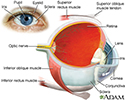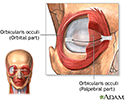Eyelid twitch
Eyelid spasm; Eye twitch; Twitch - eyelid; Blepharospasm; Myokymia
An eyelid twitch is a general term for spasms of the eyelid muscles. These spasms happen without your control. The eyelid may repeatedly close (or nearly close) and reopen. This article discusses eyelid twitches in general.
Causes
The most common things that make the muscle in your eyelid twitch are fatigue, stress, caffeine, and excessive alcohol intake. Rarely, they can be a side effect of a medicine used for migraine headaches. Once spasms begin, they may continue off and on for a few days. Then, they disappear. Most people have this type of eyelid twitch once in a while and find it very annoying. In most cases, you won't even notice when the twitch has stopped.
You may have more severe contractions, where the eyelid completely closes. This form of eyelid twitching is called blepharospasm. It lasts much longer than the more common type of eyelid twitch. It is often very uncomfortable and may cause your eyelids to close completely. Twitching can be caused by irritation of the:
- Surface of the eye (cornea)
- Membranes lining the eyelids (conjunctiva)
Sometimes, the reason your eyelid is twitching cannot be found.
Symptoms
Common symptoms of eyelid twitch are:
- Repeated uncontrollable twitching or spasms of your eyelid (most often the upper lid)
- Light sensitivity (sometimes, this is the cause of the twitching)
- Blurry vision (sometimes)
Treatment
Eyelid twitching most often goes away without treatment. In the meantime, the following steps may help:
- Get more sleep.
- Drink less caffeine.
- Consume less alcohol.
- Lubricate your eyes with eye drops.
If twitching is severe or lasts a long time, small injections of botulinum toxin can control the spasms. In rare cases of severe blepharospasm, limited removal of some of the muscles around the eyelids or brain surgery may be helpful.
Outlook (Prognosis)
The outlook depends on the specific type or cause of eyelid twitch. In most cases, the twitches stop within a week.
Possible Complications
There could be some loss of vision if the eyelid twitch is due to an undetected injury. This occurs rarely.
When to Contact a Medical Professional
Make an appointment with your primary care provider or eye doctor (ophthalmologist or optometrist) if:
- Eyelid twitching does not go away within 1 week
- Twitching completely closes your eyelid
- Twitching involves other parts of your face
- You have redness, swelling, or a discharge from your eye
- Your upper eyelid is drooping
References
Cioffi GA, Liebmann JM. Diseases of the visual system. In: Goldman L, Cooney KA, eds. Goldman-Cecil Medicine. 27th ed. Philadelphia, PA: Elsevier; 2024:chap 391.
Phillips LT, Friedman DI. The efferent visual system disorders of the neuromuscular junction. In: Yanoff M, Duker JS, eds. Ophthalmology. 6th ed. Philadelphia, PA: Elsevier; 2023:chap 9.17.
Salmon JF. Neuro-ophthalmology. In: Salmon JF, ed. Kanski's Clinical Ophthalmology. 9th ed. Philadelphia, PA: Elsevier; 2020:chap 19.
Thurtell MJ, Rucker JC. Pupillary and eyelid abnormalities. In: Jankovic J, Mazziotta JC, Pomeroy SL, Newman NJ, eds. Bradley and Daroff's Neurology in Clinical Practice. 8th ed. Philadelphia, PA: Elsevier; 2022:chap 17.
Review Date: 7/9/2024





